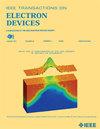A High-Voltage Dual Direction Silicon-Controlled Rectifier Based on Flexible Stacking Strategy
IF 2.9
2区 工程技术
Q2 ENGINEERING, ELECTRICAL & ELECTRONIC
引用次数: 0
Abstract
Electrostatic discharge (ESD) is a critical factor affecting the reliability of automotive electronic chips. However, the structural design of conventional on-chip high-voltage silicon-controlled rectifiers (SCRs) presents numerous challenges. Currently, there is a lack of a simple ESD solution to address the reliability issues in the aforementioned field. Therefore, this brief proposes a simple high-voltage dual direction SCR (DDSCR). The device can achieve a multiplicative increase in holding voltage (一种基于柔性堆叠策略的高压双向可控硅整流器
静电放电(ESD)是影响汽车电子芯片可靠性的关键因素。然而,传统的片上高压硅控整流器(scr)的结构设计面临着许多挑战。目前,缺乏一种简单的ESD解决方案来解决上述领域的可靠性问题。因此,本文提出了一种简单的高压双向可控硅(DDSCR)。该器件通过灵活调整单元结构的ESD特性和利用短路电阻的堆叠布局,可以实现保持电压(${V} _{h}$)的成倍增长,而触发电压(${V} _{{t}{1}}$)基本不受串联单元器件数量的影响。我们使用标准的0.18- $\mu $ m双极cmos - dmos (BCD)工艺验证了所提出结构的有效性,并通过计算机辅助设计(TCAD)仿真进一步分析了其工作原理。测试结果表明,所提出的堆叠策略具有良好的通用性,为各种高压应用的片上ESD研究提供了一种简单可靠的解决方案。
本文章由计算机程序翻译,如有差异,请以英文原文为准。
求助全文
约1分钟内获得全文
求助全文
来源期刊

IEEE Transactions on Electron Devices
工程技术-工程:电子与电气
CiteScore
5.80
自引率
16.10%
发文量
937
审稿时长
3.8 months
期刊介绍:
IEEE Transactions on Electron Devices publishes original and significant contributions relating to the theory, modeling, design, performance and reliability of electron and ion integrated circuit devices and interconnects, involving insulators, metals, organic materials, micro-plasmas, semiconductors, quantum-effect structures, vacuum devices, and emerging materials with applications in bioelectronics, biomedical electronics, computation, communications, displays, microelectromechanics, imaging, micro-actuators, nanoelectronics, optoelectronics, photovoltaics, power ICs and micro-sensors. Tutorial and review papers on these subjects are also published and occasional special issues appear to present a collection of papers which treat particular areas in more depth and breadth.
 求助内容:
求助内容: 应助结果提醒方式:
应助结果提醒方式:


